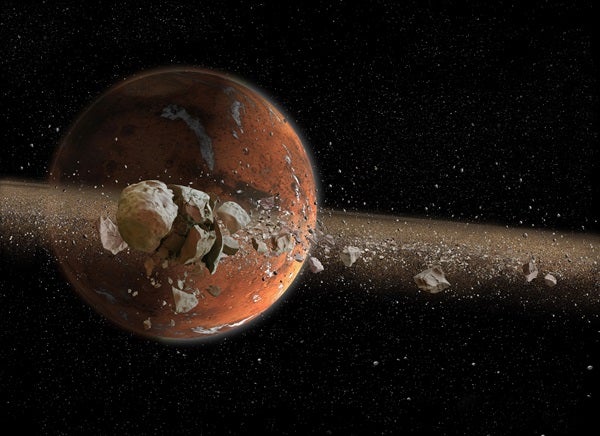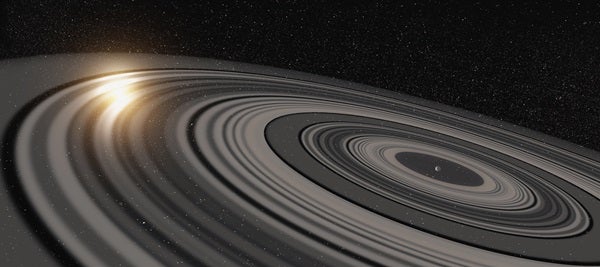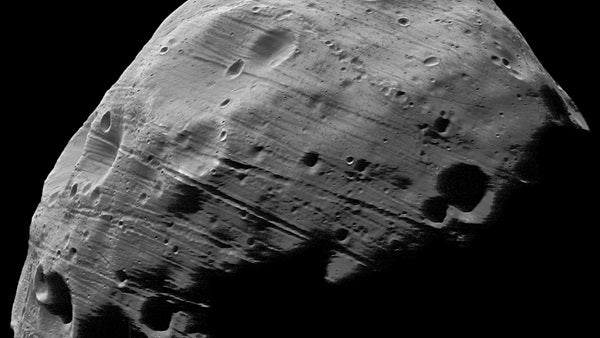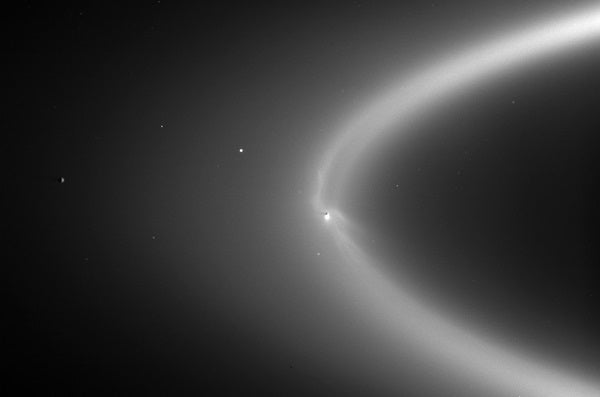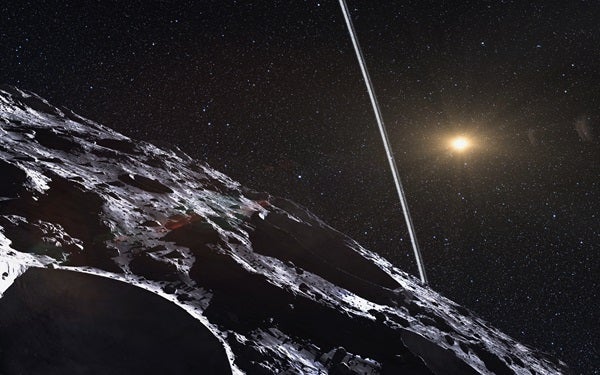Astronomers have long known that Phobos, the larger and nearer of the two martian moons, is slowly spiraling inward to eventual destruction. The end result won’t be pretty: Phobos will slip closer and closer toward Mars, then strike a gravitational line where the planet’s tidal forces will be strong enough to rip it apart. The rubble pile-like moon will break into smaller boulders, rocks, and dust, and will spread out in orbit around Mars.
Mars will join the gas giants in having a spectacular feature: a ring system.
It could be 25 million years from now. It could be up to 75 million years. Recent discoveries about the little moon’s composition and density, however, make it far more likely that its death dive will happen sooner. The pieces that don’t form a ring will fall to the surface, smashing with enough force to pockmark Mars with new craters.
“A lot of planetary science focuses on what happened in the past and what’s happening now,” says planetary scientist Benjamin A. Black. “It’s not often that we look at the future, at what will happen.” Black, a City University of New York professor, and graduate student Tushar Mittal from the University of California, Berkeley, have carried out a detailed examination of the eventual fate of Phobos.
While we know of thousands of exoplanets, only one exoring system has been found. J1407b is a massive planet with rings so large they block out their parent star’s light. It has a total of 30 systems in its rings, and the system has a diameter of 74 million miles (119 million kilometers). To put that in perspective, if the ring system were around our Sun, it would stretch all the way past Venus and fall a bit short of Earth’s orbit. J1407b is massive enough that it may not technically qualify as a planet, and may instead be a brown dwarf, a class of objects encompassing “failed stars.” The object is estimated to be 20 times more massive than Jupiter.
It appears the process of coming apart at the seams has already begun. Images of Phobos taken by the Viking orbiters and other spacecraft show a network of grooves in the tiny moon’s surface. At first they appeared to radiate from near Stickney Crater, and geologists assumed that the grooves were cracks caused by the ancient impact. Some certainly are just that, but not all. In 2015, Terry Hurford of NASA’s Goddard Space Flight Center and his colleagues reported a new analysis of the grooves. Most of them actually radiate from the side of Phobos that constantly faces Mars; tidal forces caused by Mars’ gravitational pull are deforming Phobos. Hurford believes the grooves are stretch marks, a visible sign of the inexorable grip of tidal forces on the moon.
The future martian ring will not be the only one in the solar system, of course. Nor will it be the only ring whose existence depends on a moon. There are rings across the giant planets: the four dusty rings of Jupiter; Uranus’ 13 dark, thin rings; and Neptune’s five faint rings and four enigmatic ring arcs are — like the future ring around Mars — all intimately linked to moons and moonlets. And of course, the most familiar ringed planet is Saturn, whose icy surrounding matter can be seen even through a small telescope.
Saturn’s magnificent rings
Galileo Galilei saw what turned out to be Saturn’s spectacular ring system in 1610. (He said the features looked like ears or handles.) But it wasn’t until 1655 that Christiaan Huygens identified them as an entire system of icy rings. In 1856, famed physicist James Clerk Maxwell showed that the rings must be composed of a huge number of tiny particles (he called them “brick-bats”), each independently orbiting Saturn.
Since then, debate has raged over the origin, age, and composition of Saturn’s rings. Are they leftovers from the formation of Saturn, or the remains of a shattered moon? As old as Saturn itself, or a relatively new addition? And why so much ice? Planetary scientist Robin M. Canup of the Southwest Research Institute in Boulder, Colorado, recently published a proposal that answers these questions. Canup suggests that Saturn’s rings are the very ancient remains of a Titan-sized moon.
“Saturn originally had multiple massive moons like Jupiter,” says Canup. These moons were large enough for their interiors to differentiate into layers of ices and a rocky core — less like a large comet and more like the four larger moons of Jupiter. When the large moons spiraled inward as Saturn finished its accretion, Canup says, the outer icy layers of at least one were stripped away. The core plunged into Saturn, and the icy remains eventually formed the planet’s main rings. This, she says, explains why the particles making up the rings are 99.9 percent pure water ice. It also explains the striking difference between Jupiter’s and Saturn’s rings and satellites.
“The existence of Saturn’s much more massive ring system is linked to Saturn having lost its large primordial inner moons,” Canup explains. “Jupiter retained its large inner moons, [while] its dusty ring system is vastly less massive than the ring system at Saturn.”
Phobos isn’t nearly the size of a planet, but many of the same mechanisms will drive its destruction. Its companion moon Deimos is about 7.8 miles (12.6 kilometers) in diameter and orbits Mars at an average distance of 14,580 miles (23,460km), far enough away to avoid Phobos’ fate. Phobos is 13.8 miles (22.2km) in diameter. It circles the planet at an average distance of 5,827 miles (9,377km). With an orbital period of just 7 hours, 39.2 minutes, Phobos is one of only 18 of the 181 known moons in the solar system whose orbital period is less than its planet’s rotation period.
That’s one of a few reasons why Phobos is doomed. “There are four factors in action,” explains Mittal. “The tidal force of Mars; the centrifugal forces on Phobos, which is rotating; the gravity of Phobos; and the strength of Phobos. There’s a balance among these. Tidal and rotational stresses act to pull Phobos apart; self-gravity and [tensile] strength act to hold Phobos together.”
Just as our own Moon’s gravity raises tides in both Earth’s oceans and landmasses, Phobos creates a tiny tidal bulge in Mars. The bulge moves as the moon circles Mars, just as the Moon-caused tidal bulge moves around Earth. Because Phobos has an orbital period faster than the martian day, the tidal bulge lags behind Phobos and acts to gradually slow it in its orbit, sending Phobos slowly spiraling in toward the martian surface. The rate is about 0.79 inch (2 centimeters) per year. It’s not much, but there is nothing to stop it.
“As Phobos gets closer to Mars,” says Mittal, “the tidal stresses increase.” The moon’s self-gravity and tensile strength oppose the tidal forces, but eventually Phobos will drop to a distance — called the Roche limit — where the martian gravity will win the tug-of-war. Several studies confirm that Phobos’ inward spiral will lead to its destruction in 25 million to 75 million years.
Phobos could stave off obliteration if it were a dense body, more able to resist the pull of gravity past the Roche limit. Unfortunately, data from the European Space Agency’s Mars Express orbiter show that the moon has a density of just 1.9 grams per cubic centimeter. By comparison, our Moon has a density of 3.3g per cubic centimeter. Even tiny Themisto, Jupiter’s smallest regular moon at just 4.9 miles (8km) in diameter, has an estimated density of about 2.6g per cubic centimeter. Mars Express also revealed that Phobos is porous, likely containing large voids, so it is probably a rubble pile, like many of Uranus’ and Neptune’s tiny moons.
Then there’s Stickney Crater, the giant impact basin on Phobos. Sometime in its past, Phobos was hit by an object that left a crater 5.6 miles (9km) wide — nearly half the moon’s diameter. The impact surely fractured much of Phobos’ interior, leaving it even weaker. From there, billions of years of meteoroid impacts have churned the surface of Phobos into a layer of fine dust about a hundred meters deep. Given the extremely weak surface gravity (escape velocity for Phobos is a mere 4.56 feet per second), the rock making up the rubble pile just barely stays put.
Black and Mittal used a numerical geotechnical model designed for large underground construction projects to estimate what they call the moon’s “rock mass strength.” The results place the finale for Phobos between 20 million and 40 million years from now, and give more details on its violent end.
As Phobos reaches its Roche limit, about 3,400 miles (5,470km) from the martian surface, tidal forces will start pulling Phobos apart. Just as Saturn’s tidal forces may have peeled away the icy mantle of a Titan-sized moon billions of years ago, the hundred meters or so of regolith will be stripped off Phobos. It will happen quickly: In as little as a week, the dust will spread into a ring circling Mars, the moon no more.
Depending on how much material is stripped off Phobos, the ring could initially have a mass density similar to that of today’s rings of Saturn. The martian ring will be very dark, unlike Saturn’s bright icy rings, more like the dusty rings of Jupiter that are darker, thinner, and more diffuse. It will practically hug Mars, closer in relative terms to the planet than the other planetary rings in the solar system. And the ring, say Black and Mittal, will not last long; they estimate its lifetime at between 1 million and 100 million years.
You don’t have to be a planet to have a ring. An object known as Chariklo (classified as a centaur, or outer solar system minor planet) has a thin ring system around it. Chariklo’s diameter of 144 miles (232 kilometers) puts it at the lower limits of the size of dwarf planets. The formation mechanism of the rings, and indeed much information beyond their existence, is not yet known. Chariklo was the first minor planet or asteroid to have a known ring system. Another centaur, Chiron, may have one as well. The rings were discovered in 2014. Chariklo orbits in a highly inclined orbit between Saturn and Uranus.
Other once and future rings
Is it possible that Mars possessed a ring system in its distant past? “We’re not certain,” says Black, “but it would be worth investigating whether past inwardly migrating moons may have existed. Some fraction of moons might be expected to have an orbital configuration similar to that of Phobos and Mars.”
Some planetary scientists think Mars once did have more than two moons. Researchers have identified 258 elliptical craters on Mars formed by objects hitting the surface at grazing angles. At least some of them could well have been made by oblique impacts of ancient martian moons. If so, others may have broken up before hitting the atmosphere, leaving short-lived rings of rocks and dust around Mars.
There’s no evidence that Mercury or Venus ever possessed ring systems. Earth did, though, for an extremely brief period during the formation of the Moon 4.5 billion years ago when our planet was struck by a Mars-sized body dubbed Theia. Much of Theia merged with Earth, but the “Big Splash” would have blown the remaining material into space. Computer simulations indicate about 20 percent of Theia’s mass would have gone into orbit around Earth as a ring. About 10 percent of the ring’s material then quickly coalesced into the Moon, with the rest eventually falling back to Earth. The ring would not have lasted long, perhaps as little as a month but probably no more than 100 years.
Curiously, our Moon also could end as it began, according to astronomer Lee Anne Willson, university professor emerita at Iowa State University. As part of her research on the fate of Earth as the Sun expands into a red giant, she found that the Moon stood a chance of becoming a ring around Earth.
The Moon is receding from Earth at a rate of about 1.6 inches (4cm) per year. Left unchecked, the Moon will eventually migrate out to a distance where it will take 47 days to orbit Earth. By then, Earth’s rotation also will have slowed to 47 days. The two will then keep the same face to each other, as Pluto and its moon Charon do today.
Before this happens, though, some 5 billion years from now, the Sun will enter its red giant phase. It will start expanding in size, and swallow up Mercury and Venus. As the Earth-Moon system orbits through the Sun’s expanded outer atmosphere, drag forces will cause the Moon’s orbit to begin decaying. The Sun probably will continue to expand, and destroy both Earth and the Moon. On the other hand, if the Sun should blow off about 20 percent of its mass first, the Moon will continue to spiral down to its Roche limit. Tidal forces will tear it apart, just as they will destroy Phobos.
And then, 9 billion years after the Moon’s birth from a ring of molten impact ejecta, and nearly 5 billion years after the birth and death of the ring around Mars, Earth will once again have a ring.

